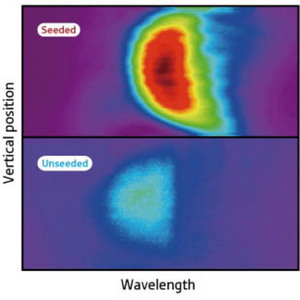Jun. 13, 2008 Research Highlight Physics / Astronomy
Sowing the seeds for improved lasers
The use of seed lasers significantly improves the emission characteristics of free-electron lasers
 Figure 1: Comparison between seeded (top) and unseeded (bottom) FEL emission at a wavelength of 160 nm. The seeded FEL beam shows a much higher intensity and better beam profile. The slight distortion of the beams is an experimental artifact. Modified from Ref. 1 © 2008 Nature Publishing Group
Figure 1: Comparison between seeded (top) and unseeded (bottom) FEL emission at a wavelength of 160 nm. The seeded FEL beam shows a much higher intensity and better beam profile. The slight distortion of the beams is an experimental artifact. Modified from Ref. 1 © 2008 Nature Publishing Group
Free-electron lasers (FEL), where high-density electrons are accelerated so that they emit intense laser radiation in the so-called vacuum ultraviolet (VUV) and x-ray part of the spectrum, are an invaluable tool for materials research and the characterization of biological samples. Researchers from RIKEN’s SPring-8 Center in Harima, in collaboration with scientists from the French technological research agency CEA and Synchrotron SOLEIL in Saclay, have now developed a method that enhances the coherence of the radiation generated by the FEL and thereby allows for the realization of powerful lasers.
In an FEL, the electrons follow a wiggling path in so-called undulators, analogous to a skier racing around slalom poles. This process creates strong light emission. To achieve lasing, the emission process needs to occur in a coordinated manner, a requirement that necessitates a long wiggling path where the laser action is slowly built up. However, owing to a lack of suitable materials for these short wavelengths, the FEL has no mirrors between which the light oscillates back and forth. Therefore, unlike conventional lasers, the light emitted is not synchronized by the repeated reflections from the mirrors and shows little temporal coherence. To compensate for this deficiency and achieve full temporal coherence, physicists have proposed feeding in an external ‘seed’ laser beam of the same frequency to the FEL. Furthermore, the seed would shorten the length of the wiggling path, resulting in a compact facility.
Reporting in the journal Nature Physics 1, the researchers demonstrate the realization of this concept. “This is the first time that this experiment has been done in a short-wavelength FEL,” explains Toru Hara from the team. Indeed, impressive improvements in laser intensity of three orders of magnitude have been achieved (Fig. 1), whilst the laser spectra are now much more stable.
In the present study, the fundamental wavelength is 160 nm but the researchers have already demonstrated FEL laser output at wavelengths as short as 32 nm. Indeed, Hara explains that “in principle, this method can be extended down to wavelengths around 10 nm”—close to the important region of 2–3 nm, where water is transparent. This is particularly advantageous to biological studies as the laser can penetrate much farther into tissue. However, new seeding schemes may be required to produce these shorter wavelengths. Nevertheless, the improvements in light characteristics, such as temporal coherence, already offer significant advantages to researchers using free electron lasers in their work.
References
- 1. Lambert, G., Hara, T., Garzella, D., Tanikawa, T., Labat, M., Carre, B., Kitamura, H. Shintake, T., Bougeard, M., Inoue, S., et al. Injection of harmonics generated in a gas in a free-electron laser providing intense and coherent extreme-ultraviolet light. Nature Physics 4, 296–300 (2008). doi: 10.1038/nphys889
